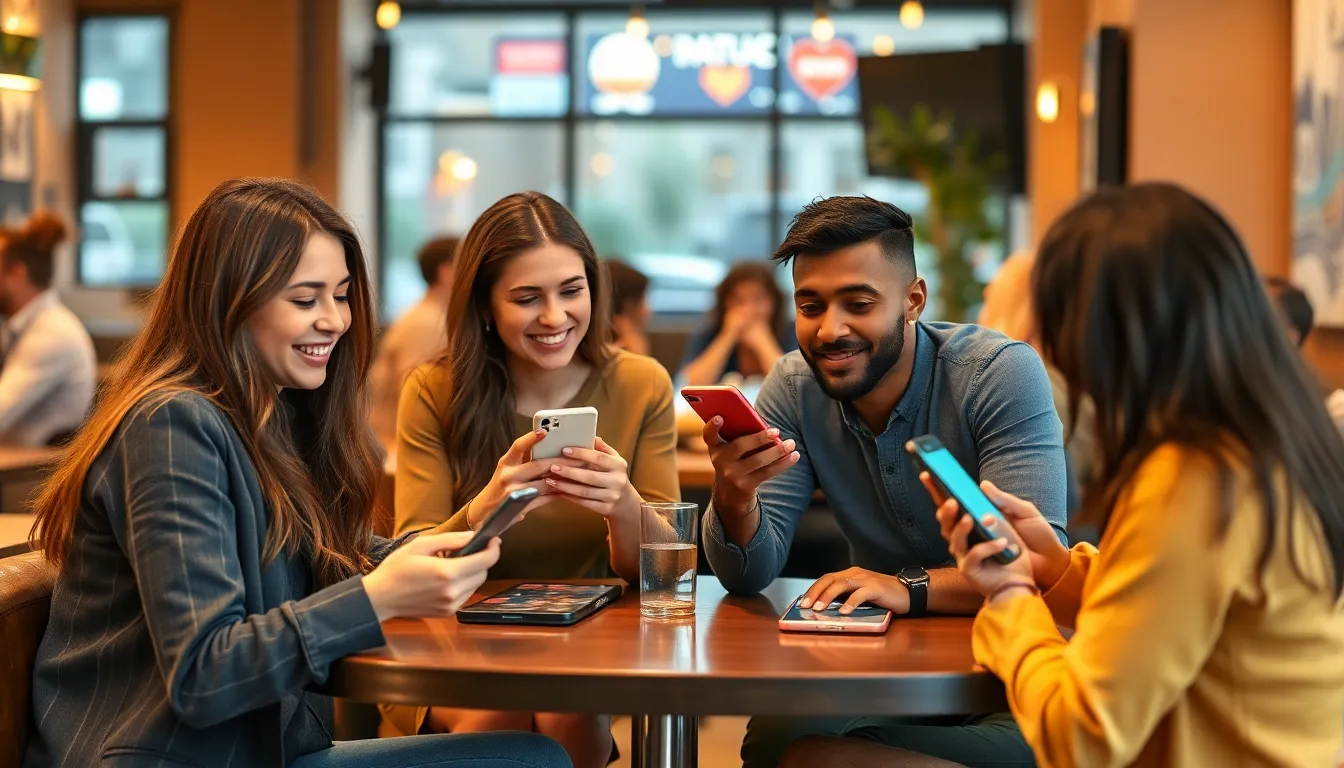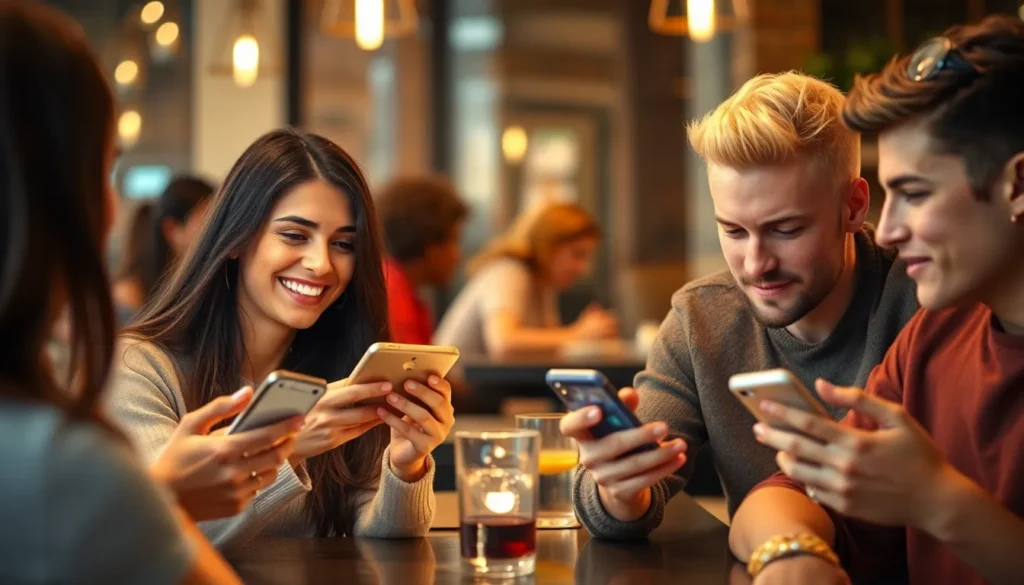Table of Contents
ToggleIn a world where swiping right can lead to love—or at least a decent pizza date—dating apps have become the modern matchmaking marvel. Gone are the days of awkward encounters at bars or blind dates set up by well-meaning friends. Now, with just a few taps, anyone can dive into a sea of potential partners, each with their own quirks and stories.
Overview of Dating Apps
Dating apps emerged as a significant tool for modern matchmaking. Popular platforms like Tinder, Bumble, and Hinge cater to diverse demographics, offering users tailored experiences. Users create profiles that showcase interests, photos, and preferences, facilitating connections.
The ease of swiping has become synonymous with the dating app experience. Many people engage through short, engaging bios instead of lengthy introductions. Conversations tend to initiate through messages, allowing users to gauge compatibility before meeting in person.
Statistics reveal growth in popularity, with approximately 30% of adults in the U.S. having used a dating app. Individuals across various age groups show interest, with 18-24 year olds making up a significant 38% of users. Preferences often determine the choice of app, as some focus on casual relationships while others emphasize serious commitments.
In terms of safety, many apps incorporate features like photo verification and reporting tools. These tools aim to enhance user security and foster a respectful environment. Efforts to create inclusive spaces also surface, with platforms catering specifically to LGBTQ+ individuals and niche communities.
User experience ranks paramount, with many individuals seeking user-friendly interfaces and efficient match algorithms. The digital landscape continues to evolve, and trends such as video dating gain traction. Changes reflect users’ desires for genuine connections in a rapidly shifting social environment.
Popular Dating Apps

Numerous dating apps cater to various preferences and dating styles. Users enjoy a range of features designed to enhance their matchmaking experience.
App Features Comparison
Tinder stands out with its swiping functionality and large user base. Bumble gives women the power to initiate conversations, adding a unique dynamic. Hinge focuses on meaningful connections through prompts in user profiles and encourages users to engage with others’ answers. OkCupid employs thorough questionnaires that help users find compatible matches based on shared interests. Each app emphasizes different features, appealing to distinct user preferences in the dating landscape.
User Demographics
Among U.S. adults, approximately 30% have ventured into the world of dating apps. Notably, the 18-24 age group accounts for 38% of active users, signaling a trend towards younger individuals seeking connections online. Users across age ranges show diverse motives, from casual dating to serious relationships. The varying demographics of dating app users offer insights into changing social norms and the evolving nature of relationships in modern society.
Safety and Security in Dating Apps
Safety remains a crucial aspect of using dating apps. Users face various risks, including privacy concerns and unwanted interactions. Awareness of these issues enhances the overall experience.
Privacy Concerns
Data privacy stands at the forefront of user worries. Personal information shared on dating apps may expose individuals to potential breaches. Many platforms collect location data, photos, and personal preferences. Protecting this information is vital for user confidence. Users should review privacy policies to understand data usage. According to Pew Research, 70% of adults express concerns about their online privacy. Users can take steps, such as using anonymous profiles and avoiding sharing sensitive information. By remaining vigilant, individuals can enjoy connections while safeguarding their personal details.
Reporting and Blocking Features
Robust reporting and blocking features serve as essential tools within dating apps. Users can report inappropriate behavior or block individuals for safety. Many platforms streamline these processes for quick access. Tinder allows users to report profiles with just a few taps. Additionally, Bumble emphasizes safety by giving women control over the conversation. This promotes a respectful environment. Users should utilize these features when necessary, knowing that many apps take user safety seriously. With about 38% of users in the 18-24 age group, fostering a safe space is especially important for younger individuals navigating online dating. Thus, active engagement with these features contributes to a healthier app ecosystem.
Tips for Success on Dating Apps
Success on dating apps often hinges on creating a standout profile and effectively engaging in conversations. These two elements significantly shape the user experience and connection potential.
Creating an Attractive Profile
Profiles should highlight unique interests and attributes. Users should select clear, recent photos that showcase smiles and activities. Write a compelling bio that reflects personality, avoiding clichés while emphasizing genuine traits. Specific hobbies and passions can pique interest and foster conversation. Users are encouraged to be honest about what they seek, whether casual or serious. This transparency enhances compatibility and attracts the right matches. Proper grammar and spelling contribute significantly to professionalism and credibility.
Engaging in Conversation
Starting conversations with open-ended questions leads to more interactive dialogues. Users should reference something in the other person’s profile to establish a personal connection. Humor often acts as an icebreaker, helping to dispel awkwardness. Maintaining a balance between asking questions and sharing personal insights keeps conversations flowing. Responding promptly shows interest and respect for the other person’s time. Users must remain attentive to the other person’s cues and adjust accordingly, fostering deeper connections. Prioritizing respectful and engaging interactions cultivates a positive experience overall.
Future Trends in Dating Apps
AI integration stands to transform the dating app landscape, offering personalized experiences. Machine learning algorithms analyze user behavior to suggest compatible matches. As these technologies evolve, users expect tailored recommendations based on their preferences and interactions.
Virtual reality dating experiences are gaining traction. Users will immerse themselves in virtual environments for more engaging interactions. These advancements promise to replicate real-life connections, enhancing the overall experience.
Inclusivity remains a priority as dating apps expand their offerings. Platforms are increasingly catering to diverse identities and orientations. This shift acknowledges the complexity of modern relationships, ensuring that everyone finds suitable partners.
Safety features continue to develop, addressing privacy concerns. Real-time location tracking during meetings helps ensure user safety. Enhanced verification processes build trust among users, promoting a secure dating environment.
Social media integration allows for seamless connections. Users can link their profiles to social accounts, showcasing interests and activities. This trend encourages more authentic interactions, fostering genuine connections.
Video dating capabilities are on the rise. They provide users with opportunities to interact face-to-face without meeting in person. This format enriches the conversation and helps users gauge chemistry before taking the next step.
Increased awareness of mental health leads to platforms focusing on emotional well-being. Features that promote healthy conversations and support systems cultivate a positive dating culture. Ultimately, users seek environments that encourage mental wellness while navigating relationships.
Mobile optimization ensures that dating apps remain accessible. Enhanced user interfaces and faster loading times improve engagement. As mobile use grows, responsive design becomes essential in ensuring user satisfaction.
Dating apps have undeniably reshaped how people connect in today’s digital landscape. With a variety of platforms catering to different preferences and lifestyles, users can find matches that align with their unique interests. The emphasis on safety and user experience continues to evolve, ensuring that individuals can engage confidently in this modern dating arena.
As technology advances, trends like AI integration and virtual reality are poised to further enhance the dating experience. This evolution reflects a broader shift in societal norms surrounding relationships, making it easier than ever for individuals to forge meaningful connections. The future of dating apps promises to be exciting as they continue to adapt and innovate in response to user needs.







